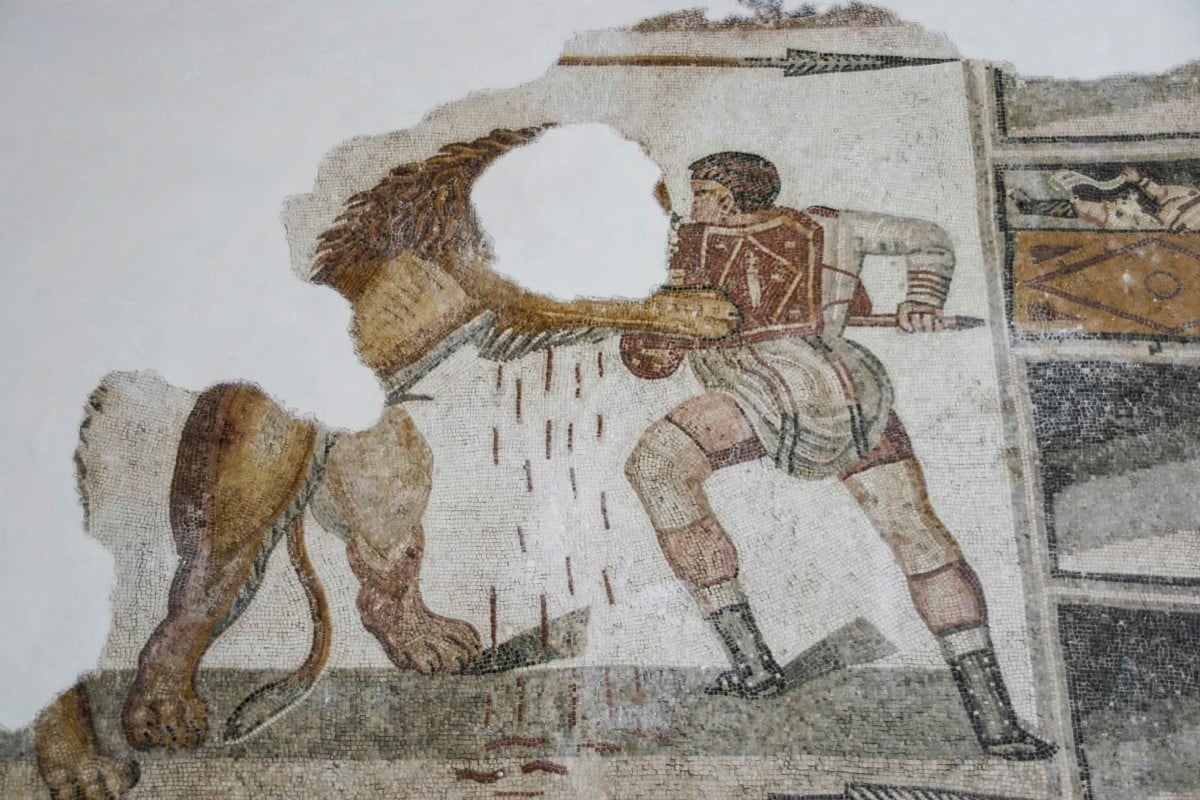
Study Buddy (Challenger): Bite marks reveal gladiator’s fatal encounter with a lion
This page is for students who want to take their reading comprehension to the next level with difficult vocabulary and questions to test their inference skills
 An ancient Roman mosaic at the Bardo National Museum in Tunis, Tunisia depicts a specialist gladiator, called a venator, confronting a lion. Photo: Reuters
An ancient Roman mosaic at the Bardo National Museum in Tunis, Tunisia depicts a specialist gladiator, called a venator, confronting a lion. Photo: ReutersContent provided by British Council
Read the following text, and answer questions 1-9 below:
[1] In Rome’s Colosseum and other amphitheatres in cities scattered across the sprawling ancient Roman Empire, gladiatorial spectacles were not merely human-versus-human affairs. While there are depictions of humans pitted against animals in ancient mosaics and texts, actual forensic evidence of these contests has been elusive until now. Scientists have determined that bite marks on the pelvis of a man buried in what is believed to be a cemetery for gladiators near the English city of York – known at the time as Eboracum – were made by a big cat, probably a lion.
[2] The man appears to have lived during the 3rd century AD, when Eboracum was an important town and military base in the north of the Roman province of Britannia. The bite marks provide clues about his suspected demise in the arena. “Here we can see puncture and scalloping, indicative of large dentition (teeth) piercing through the soft tissues and into the bone,” said forensic anthropologist Tim Thompson of Maynooth University in Ireland, the lead author of the study published last month in the journal PLOS One. “We don’t think this was the killing wound, as it would be possible to survive this injury, and it is in an unusual location for such a large cat. We think it indicates the dragging of an incapacitated (deprived of strength) individual,” Thompson said.
[3] The discovery illustrates how gladiatorial spectacles with wild animals – often presented by emperors and other influential thinkers or leaders – were not limited to the empire’s major cities and extended into its furthest-flung provinces. Researchers said this man’s skeleton represents the first known direct physical evidence of human-animal combat from ancient Roman times.
[4] Wild animals used in such spectacles included elephants, hippos, rhinos, crocodiles, giraffes, ostriches, bulls, bears, lions, tigers and leopards. For instance, in 2022, archaeologists announced the discovery of the bones of bears and big cats at the Colosseum. “Predatory animals – above all big cats but also sometimes other animals, for example bears – were pitted as combatants against specialist gladiators, known as venatores,” said study co-author John Pearce, a Roman archaeologist at King’s College London.
[5] Pearce said that large and aggressive animals were pitted against each other – a bull and bear, for example – and often chained together. Simulated hunts were also staged in arenas, with humans against animals and animals against other animals. Animals were sometimes used as a means of execution for captives and criminals, where the victim was bound or defenceless, Pearce said.
[6] Gladiators were typically enslaved people, prisoners of war, criminals and volunteers. “A popular reputation – as expressed in fan graffiti at Pompeii – money and the possibility of being freed as a successful arena star were incentives and rewards for gladiators,” Pearce said. More than 80 human skeletons, mostly well-built younger men, have been excavated at the cemetery. Many had healed and unhealed injuries consistent with gladiatorial combat and had been decapitated, perhaps by losing a bout.
Source: Reuters, April 23
Questions
1. In paragraph 1, the discovery of bite marks on a man’s pelvis is significant because it …
A. confirms the existence of big cats in ancient Britain.
B. provides evidence that gladiators were sometimes buried with the animals they fought.
C. offers concrete proof of a type of gladiatorial contest previously known mainly through art and writing.
D. none of the above
2. According to paragraph 2, what characteristics of the bite marks on the man’s pelvis suggest that a large animal inflicted the bite?
3. Based on paragraph 2, the bite marks on the pelvis suggest …
A. the lion attacked and killed the gladiator with a bite to that region.
B. the gladiator sustained the injury before fighting the lion.
C. the lion was partially immobilised when it attempted to drag the gladiator.
D. none of the above
4. Where does the phrase “further-flung provinces” in paragraph 3 refer to?
5. In paragraph 4, what does the phrase “above all big cats” suggest about the use of these animals against venatores?
6. Based on paragraph 5, describe two traits of the animals chosen to fight against other animals.
7. According to paragraph 5, which of the following can be inferred about the “simulated hunts” staged in arenas?
A. They exclusively featured unarmed humans facing large predatory animals.
B. They involved both human-versus-animal and animal-versus-animal confrontations.
C. They usually resulted in the death of all the animals involved.
D. They were mainly used to train venatores for gladiatorial combat.
8. Find a term in paragraph 6 that refers to people bought by others and forced to obey and work for them.
9. What do the excavated skeletons in paragraph 6 suggest about the nature of gladiatorial combat?
Answers
1. C
2. The puncture and scalloping of the bite marks indicate large dentition (teeth) piercing through soft tissues and into the bone, suggesting a large animal.
3. D
4. places such as Eboracum (accept all similar answers)
5. Big cats were frequently used in combat against venatores. (accept all similar answers)
6. They were large and aggressive.
7. B
8. enslaved person
9. Gladiatorial combat is violent and leads to major injuries and death. (accept all reasonable answers)
